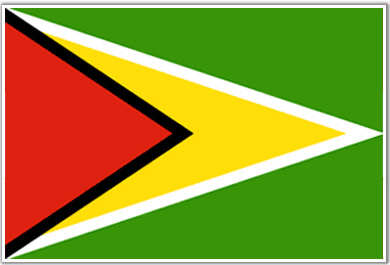 Guyana 1999
Guyana 1999 
Collecting and Studying Fish
Text and photos by Alf Stalsberg,
unless otherwise indicated.
CLICK ON ANY IMAGE TO ENLARGE IT
Guyana is not the first country people go to, in fact I think there are very few people going there. Why? Well it's not a tourist place, even though there are a lot of things to see and do. For a start, there are no beaches.
But if you go there to study the fauna, you will find a lot. I do not think I have seen much of the wildlife before on my trips. I have seen some of it, but not so much as this time in Guyana.
So let me start at the beginning. Why go there in the first place? Well there were some fish I wanted to bring back: Aequidens potaroensis, Apistogramma, Nannacara, Livebearers, Corydoras and more.
I started to plan the trip in good time, staying out in the bush needs some planning. First checking out the ticket price and how to get there.
We flew from Norway to London to meet my other friends, and started out on the wrong foot, nearly missing our plane. You see we were so happy after a loooonng wait to check-in, when we were ready we went into a pub to cool down with a beer.
Finished the first beer, order another one, and one of the boys said, "what time was the departure?" One grabbed the ticket, looked and said, "the plane is leaving a quarter after twelve!" The time was five minutes past twelve. Guess who got a rocket in the back!? We jumped up and ran to the gate as they were saying "last call", but we made it.
We flew with BWIA, to Trinidad and landed first at Barbados and then Trinidad. At Trinidad we had to wait four hours before we flew to Georgtown in Guyana.
While waiting at the airport in Trinidad, we were discussing what BWIA was short for. We did not find anything before I went to the loo. You all know about the writings on the wall, and there I found the translation for BWIA: "Britain's Worst Investment Abroad"? We found out later what the letters actually stood for, and that was "Best West Indies Airlines". I had nothing to complain about with the airline.
We got our baggage and passed through Customs, then we could walk out from the airport in Guyana.
Outside we were met by an English friend of mine named Duncan Pears. He was working there in Guyana on a two-year contract as a teacher in forestry. A very nice guy, and he helped us a lot. He met us with the small school bus, and we got all our stuff in it and headed for our hotel. Our hotel was not the Sheraton, but a small and very nice guest house with very nice and friendly owners.
When we had settled in our rooms we went out and down to a Chinese Restaurant called New Thriving Restaurant, and this was good.
In the morning the day after and after a good breakfast, we decided to take a look at the Paramaribo town. We did not go far, and we brought our dipnet. Outside the guesthouse there was a small ditch with not much water, but there were fish there, guppies and Poecilia picta.
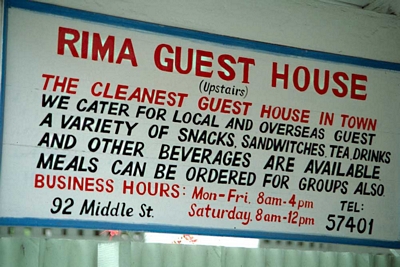
The sign outside the Rima guesthouse, the cleanest in town. |
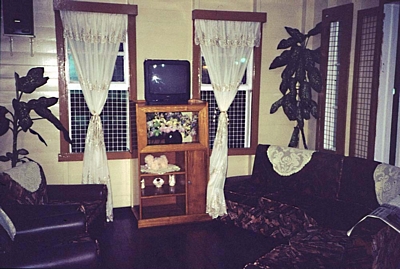
|
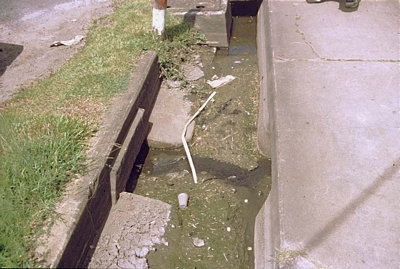
|
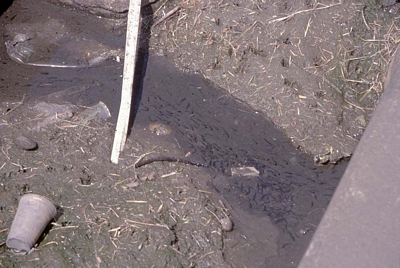 |
| The fish tried to find a place in the shadow under the small "bridge", but there was not enough room for all.
|
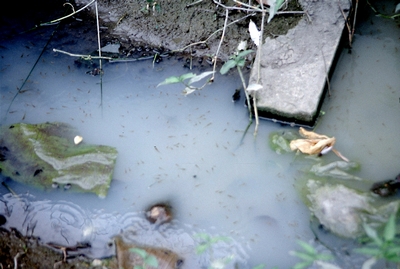
Later there was a shower that increased the amount of water in the ditch and cooled it down a bit. |
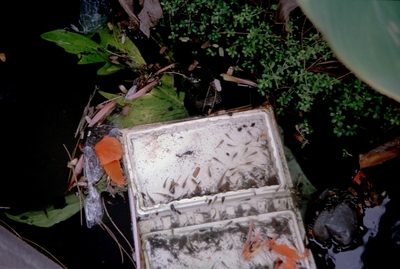
There were fish even in an empty film cover. |
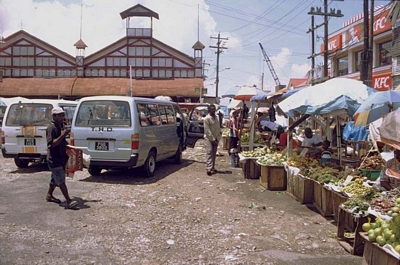 |
We were waiting on our contact person, Duncan Pears, and he came and guided us to the square where there was a marketplace. |
From there we planned to take a trip to the Botanical Gardens to have a look there.
BELOW: Before we got that far, we stopped to watch a boy collecting fish in a canal.
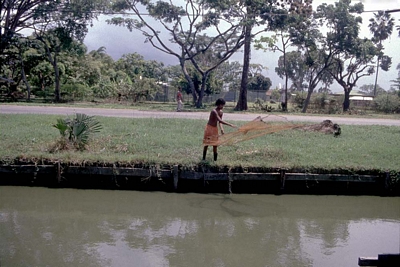
|
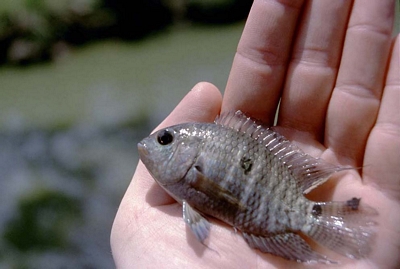
ABOVE: He had collected a Cichlasoma bimaculata and a Hypostomus sp. |
There was also a zoo there and a small aquarium that was not very impressive. After the zoo it was back to the guesthouse for lunch and a little nap.
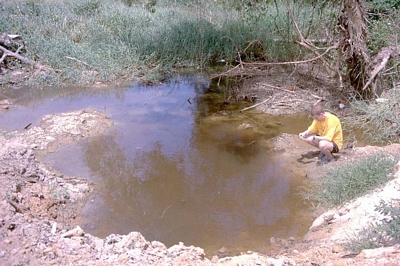 |
We made a stop before Mahaica to check out a pond. |
The day after we picked up our cars and went out to start collecting fish. We decided to go down along the coast to see what we would find. We were going down to a place called Mahaica, but we made a stop before that to check out a pond. There we collect Poecilia picta and a Molly type.
We took water samles too: pH was 6.8 dH 3 Nitrit 0 and the position was N-06-44'25" and W-057-57'020", and the temperature at noon was 31°C in the water and 35°C in the air.
Then we continued to Mahaica and took some photos of an Anableps type and then a few cold beers before we drove further out to a place called Can Grove.
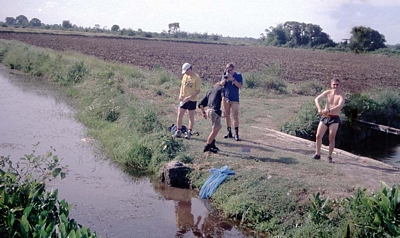 |
We collected several type of fish: Cichlasoma bimaculata, Nandida (Schomburgi), Nannostomus beckfordi, Copella, Gold Tetra, Hemmigramus type, Rivulus type, Apistogramma steindachneri and Crenicichla sp. |
After breakfast the day after we started on the road up to Linden, but we did not get very far before we had to stop to check a place called Madwani Creek. It was very tea-colored water and the sight underwater was not very good.
So we crossed the road and entered some small ponds, you could call them mudholes, but we did collect fish there. It was Rivulus sp., Leaf Fish, Copella type, and in the river I collected Crenicichla sp., A. steindachneri, Nannostomus marginatus, and a Nannostomus sp. "unilineatus" that was very pretty. We also collected a small Flag Cichlid (Mesonauta) and Poecilocharax weitzmani, Crenuchus spilurus, and then an Acaronia or maybe it was Branchopsis(?).
The water samples at Madwani: pH 6.4 dH 6 kH 0 and nitrite was 0. Position was N 06-30' W 50-12'.
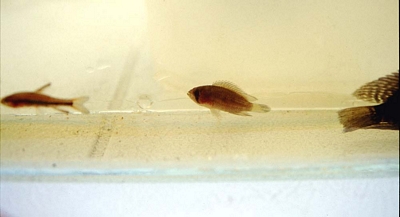 |
. |
A little further up the road we stopped at a small river in a place called Kurukuru. This also had black water, but was a better biotope to dive in.
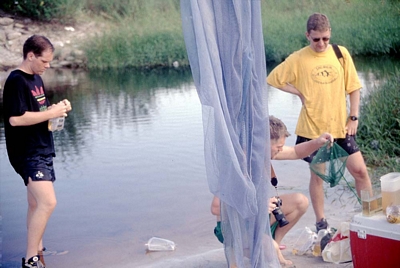 |
. |
We collect Loricaria, A. steindahneri, possible Aequidens tetramerus, Crenichicla sp., Mesonauta, different tetras and Nanacara anomala. ph 6.4, dH 6 and kH 0. Water temperature 24.5°C and air was 33°C.
Time goes fast when you are enjoying yourself like we were. We decided to continue up to Linden because it was the end of the day and we were not sure how far it was, and we needed to find a place to stay.
We passed several nice biotopes on our way up to Linden and decided to make some stops when we were going back to Georgetown.
The hotel we found looked good. I am not sure if it was the hotel or the owner of the hotel who had the name Barrow, but it was okay. And we had a nice breakfast the day after.
Our plans were to go to a place called Mabura Hill. There was also a big sawmill there, but we did not come that far. We went to a gas station to fill the cars up before we went further, but when I turned into the gas station the car died.
To make the story short, the camshaft was broken. I called the Budget office in Georgtown and told them to come with a new car. They had to get a new camshaft before they could come, so that day was gone, but we fixed the car.
The day after we headed to Mabura Hill and we found that we were on the right track. No-one here had thought it was necessary to show people a sign, telling them that this was the right way. After about 50 km we saw a road going left into the forest, we decided to stop and get something to eat.
We knew that on this ridge we would not find any rivers, but while we were eating two guys come along and we asked them if there were any rivers here. They said that if we followed the track down for about two miles we would find a small river. We decided to go down the track to see if we could find the river. The track divided several times, so we placed some branches to mark the way, so we could find the track back to the cars. On our way down to the river we met a rather long snake, it was dark-green with a yellow belly. We took some photos, but kept a distance, we did not know if this snake was dangerous. Later we were told that it was not dangerous, it was an egg-eating snake.
It was about 2.5 km down to the river. It was crystal clear, but rather cool.
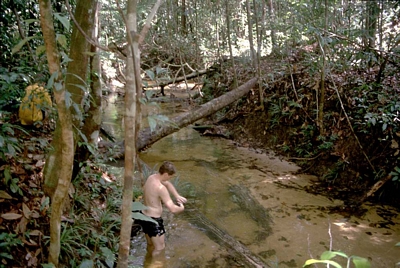 |
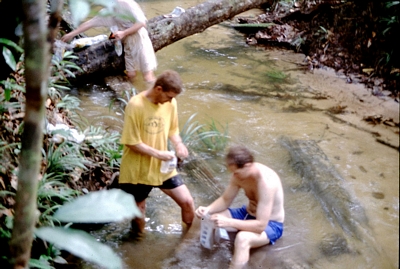
As you can see, the water is clear and there were a lot of Corydoras there. |
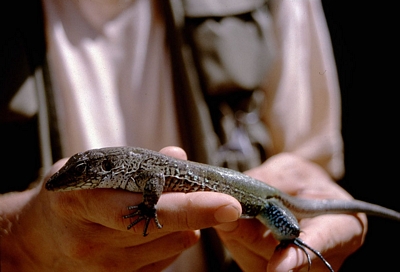
|
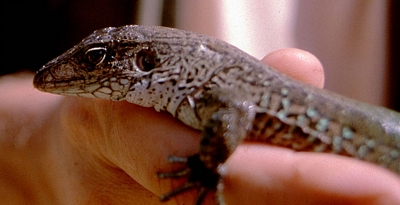
We did see many small lizards ... |
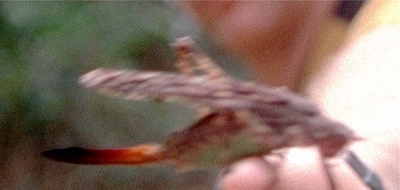
|
... and the biggest Grasshopper I have ever seen.
The photo is not very good, but it is the only one I have. |
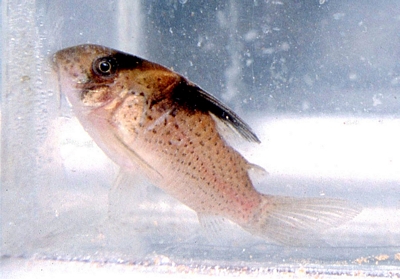
|
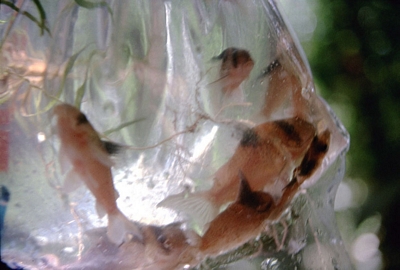
We did see many small lizards ... |
There were a lot of Corydoras, Crenicichla sp., and three tetra types. The current was rather strong, but there was no problem being in the river. Tthere was fine, white sand in the river.
It was 48.7 km from the little bridge out from Linden to where we parked our cars. Water temperature was 24.3°C, the air temperature was 28°C, pH 5, dH 0, kH 0 , nitrite > 0.1 and GPS position was 05°-44'25.9"N and 58°27'29"W.
The next day we drove on the road to Rockstone. After about 21 km from Linden, we came to a couple of huts, and if there are houses, there is usually water close to them, and so it was here.
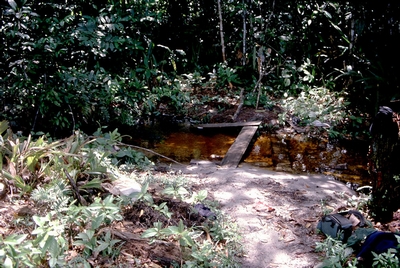 |
We found a small stream with clear, tea-colored water. |
There we collect a Nannacara sp., Apistogramma steindachneri, Rivulus sp., Splashing Tetras and some yellowish tetra. Water temperature was 25.8°C, air was 31°C, pH was 5, dH 1, kH 0 and nitrite >0.1. GPS position was 5°58'36.1"N and 58°31'11"W.
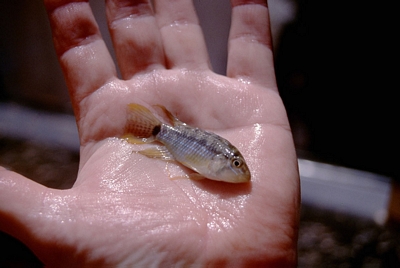
|
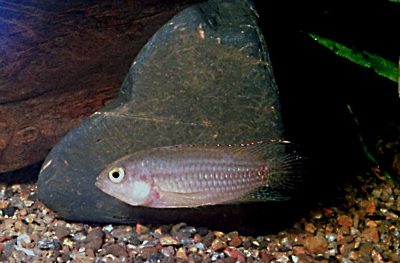
Nannacara sp. Rockstone Road. |
About 5-600 metres ahead we came to a small river with the same type of water (maybe the same river). The current was strong and it also had nice white sand. So we just had to get into the water.
I collected a couple of Crenicichla, Rhineloricaria, Paraoctocinclus sp., Rivulus, tetra type, Apistogramma steindachneri and Characidum sp. Water temperature 25.8°C, air 31°C, pH 5, dH 1, kH 0, nitrite > 0.1.
GPS position was not so very different from the other place because they were close to each other. The position was 5°58'62"N and 58°31'48"W.
We continued toward Rockstone and there we were told that we could not get out to Rockstone with our cars. We needed a 4x4WD Jeep. We drove out a little on the road, but we saw quickly that the ponds and hollows were too deep for our cars.
We turned around and decided to go back to Linden, but when we came there the other guys wanted to go back to Georgetown. It was a good road from Linden to the road crossing where we came into the road from the airport. This road was not so good, it was bumpy, there was no light, many people in the road, cars with bad lights and they have put piles of sand that cover nearly half of the road. Holes you could not see, so it was a hell to drive there.
I don't recommend driving in the dark, if it's not absolutely necessary, and I try to avoid it. After some sightseeing (not finding the right road in the dark), we found our hotel, in the dark. Then a quick shower and down to the Chinese restaurant to eat. From Linden and down to Georgtown it was about 100-110 km.
We did not do much the day after, we made an arrangement to rent a 4x4WD with a driver. This car was a Toyota Hi-Lux and the driver's name was Jerry. We could not rent a 4x4 in Guyana, so that is why we had to rent a car with a driver. He turns out to be great guy, and we hired him from Monday and we would see how many days we needed him. We wanted to go inland to the Rupunini Savannah to an Indian village with the name Annai.
Here we have loaded up the car and are ready to go. Jerry is on the right. We have put our fish boxes up on the rack and the truck body. The rest of the guys are sitting in the car. |
|
First we went up to Linden and then continued on toward Mabura Hill, but we made several stops to look at places that looked promising and ended up in Mabura Hill in the evening.
There was a hut there where we could hang our hammocks and make some food. And we could even buy beer there. We wanted to continue to the Indian village Annai the day after. But, of course we had to check interesting places before we got that far.
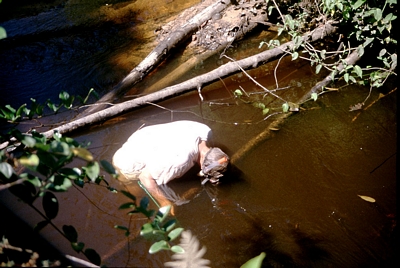
We had to check the rivers we saw. |
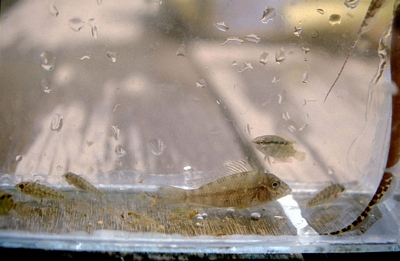
A mixed collection of fish.
|
It was good that we had a 4x4 car, or I don't think we would have made it to the Rupunini Savannah and Annai. The road was bad, but out to the Essequibo River it went rather well.
When we came to the river the ferry had stopped for the evening, even though we could see the ferry on the other side. But there was a guy Jerry knew well, and he offered us a place in his camp. There we could make our food and put up our hammocks. We changed the water on our fish before we drove to Martin's camp.
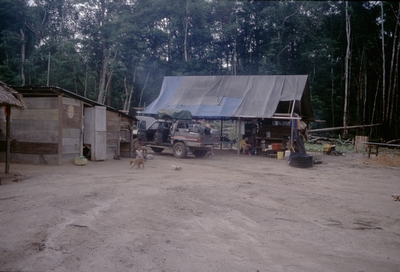
RIGHT: We hung up our hammocks in this hut, and slept well. Max is writing his memoirs. |
LEFT: He could sell us Coke (warm) but it tasted not too bad.
|
After breakfast the day after, we drove down to the ferry and it was working, so we drove the car onboard. It was just a short trip to cross the river. |
|
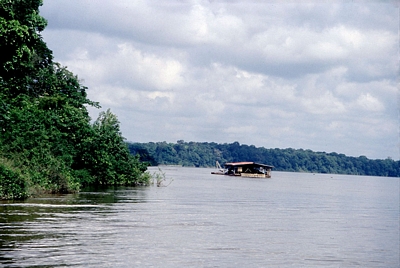 |
Here is a barge washing out gold in the river. They pump up sand and water and the gold ends up in the strainer. |
Here we are driving ashore, and we are going to make a stop at "Three Miles Creek". |
|
Three Miles Creek had a little creek and it was only a place where they stop to take a break, fill up with water and gas in the cars, and talk a little.
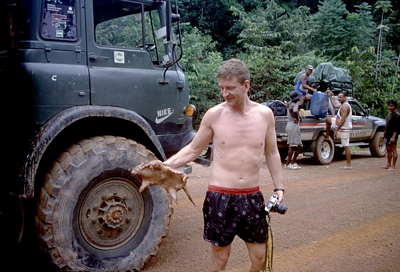
There we saw a small armadillo ... funny creature. |
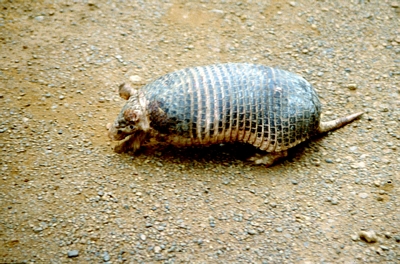 |
After the break we continued, and I have not seen so many different animals as I did on this trip in Guyana.
A little further ahead we had to make a stop again, there was a sloth crawling across the road. The sloth did not go very fast, they are not made for this, so we stopped and helped it out of the road and up into a tree.
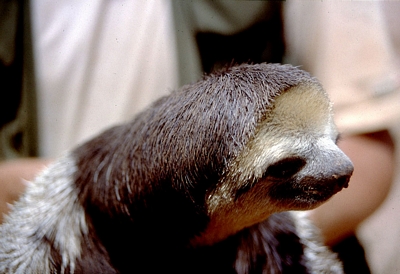
|
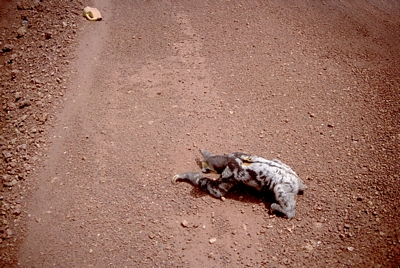
|
A closeup of the sloth ... funny animals. I have never been
so close to one before.
I guess it felt much better up in the tree.
|
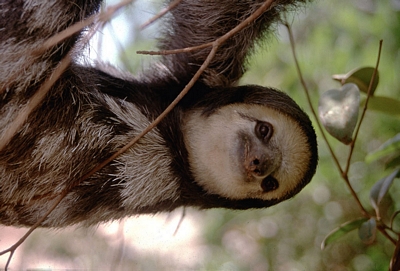
|
We did not go very far before we saw a snake crawling a cross the road, so we made a new stop to take some photos, it was a Rainbow boa. Very nice markings on it, especially on the tail. It was not sooo big, and I have no idea how big it can be.
It was not happy when I grab the tail to pull it out into the road so we could take some better photos, this is a Boa, so it's not venomous. Erik grabbed it and the snake coil up on his arm and we could see the sharp teeth.
In the photo we can see the sharp teeth, and as I said it's not venomous. |
|
We continue towards Annai, and the road was not very good.
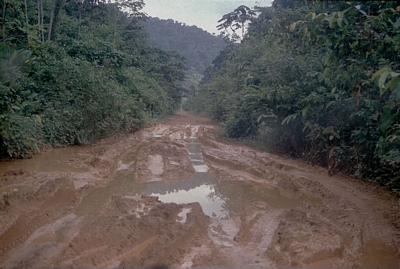
Here you can see what some parts of the road look like, and without a 4x4 we would not have made it. |
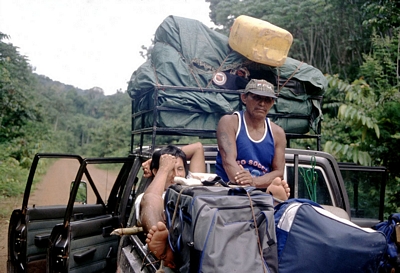
|
But there was more; in some places we could have used an amphibious vehicle/boat. You could not see the road so we waded through, and had to stop several times to empty the airfilter of water. You shouldn't be surprised when on the map you can read "Cattle trail".
The water is in the road and there are no ditches that can take care of the water, so you just have to wade through. It was lucky for us that Jerry had been driving here many times and knew where to go in the ponds.
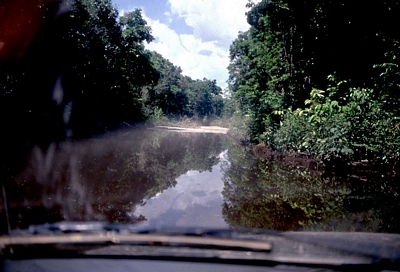
The road!! |
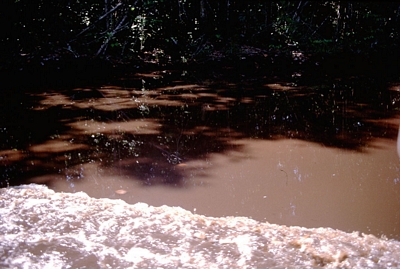
|
Water skiing behind the car would be better here. But we got through and found a small river with nice water so we could change the water on our fish.
There were a couple of guys from French Guyana that had planned going to Brazil on motorbikes. This did not go very well; the bikes stopped in all the water. Lucky enough, Jerry could help them to start the bikes so they could continue.
The bikes stopped in all the water. |
|
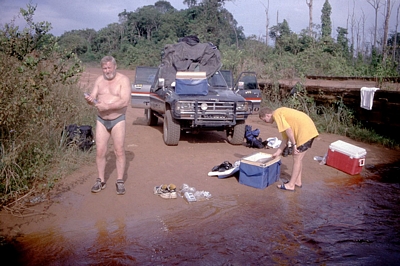 |
Here we found a nice small river so we could change water on our fish. |
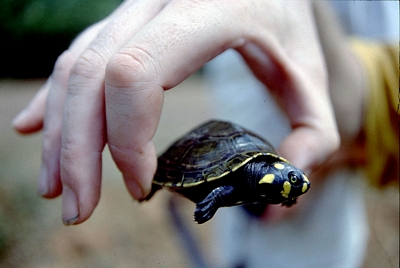
Of course we had to check this river too, to see what we could find. Here we collected a small tortoise, Splashing Tetra and Corydoras sp. |
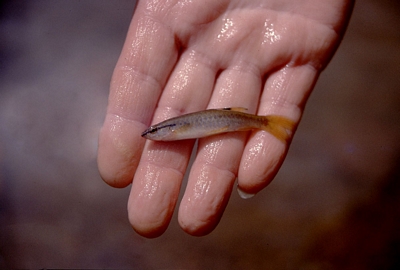
|
Then we saw a sign saying we were leaving Wokrama Forest and coming into the Amerindian district Annai. |
|
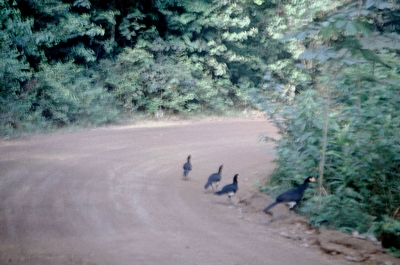 |
We saw some big birds in the road, they were picking in the sand. The photo is not good, but the birds were very cautious and flew away. |
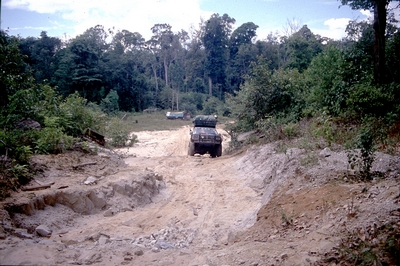
|
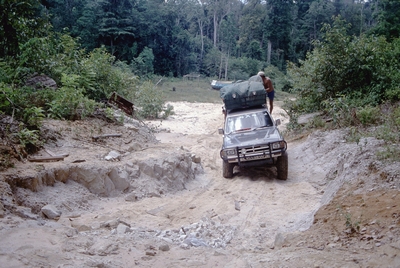
|
|
Well the road was still not the best, but we managed the Rupunini Savannah.
We came through here too, and then the road was not too bad out to the Rupunini Savannah.
|
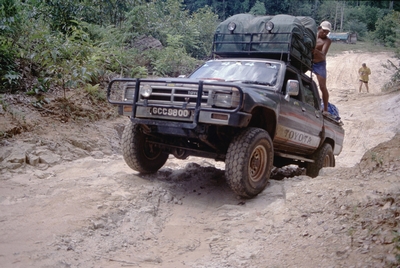
|
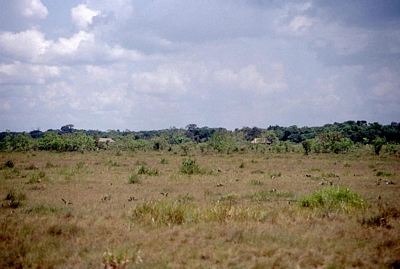
Now we are out of the forest and out on the Savannah. |
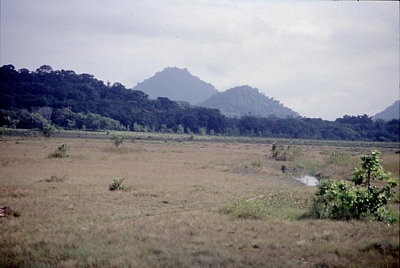
The photos do not give you the right impression of the Savannah. In the rainy season a large part of the Savannah is flooded.
|
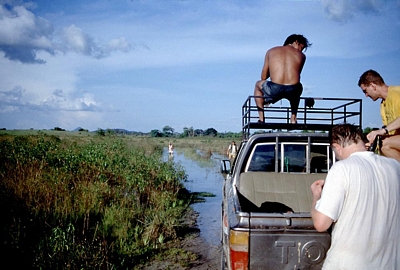
We had to get out of the car to check if we could pass. |
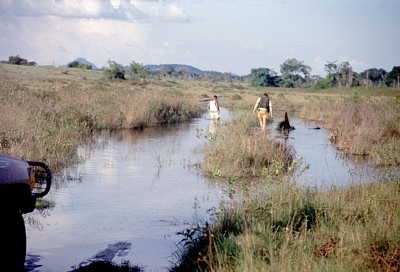
It was not the best road so we had to check.
|
But we managed to reach the Rupunini River. |
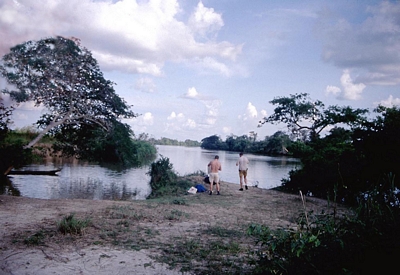
|
We did not collect a lot of fish, since we wanted to get back to Annai while it was still daylight. Next day we were planning to go back to Georgtown.
When we came back to Linden we decided to take a break, and the beer did not taste bad. |
|
Next day we were planning our last place to go, and that was to fly up to the Amerindian Village, Kamarang. When we came to Georgtown we bought some fresh fruit. The pineapple there is great.
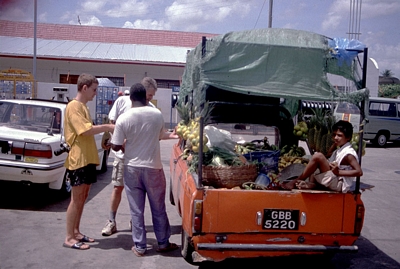
Buying fruit. |

At last back at the Hotel in Georgtown and we got the same room |
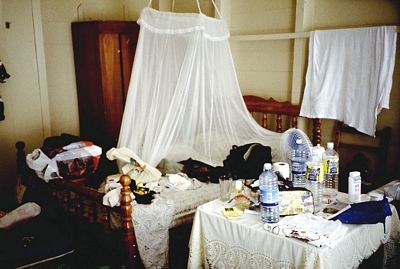
It usually becomes a little messy when you are having things around. |
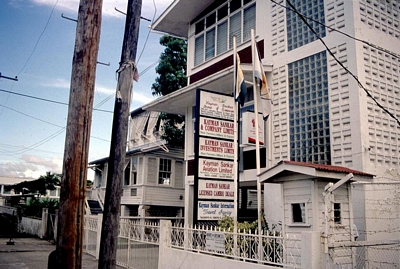
And it was good to sleep in a bed again. |
The day after we went down to Shankar Travel Agency to ask when there was a plane available to Kamarang? There was only one plane a week, that was today, and it was full. So we had to charter a plane, and that would cost US$613 one way for a small Cessna 206 with five seats.
The departure would be 14:00 the next day. So there was not much to do this day, so we went to a restaurant to have lunch. Then we needed to go to Duncan's place to place our fish in several buckets. We could not bring our fish to Kamarang, the weight would be too heavy.
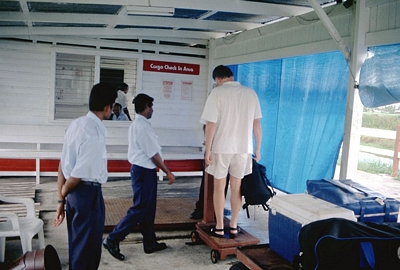
Here they are checking our weight. Not on a digital scale! |
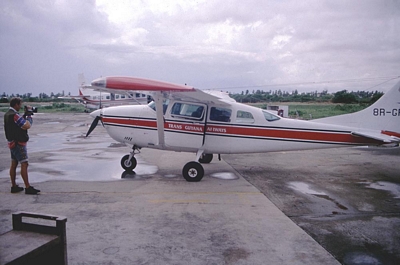
Our five-seat Cessna 206 on the strip at Ogl airport.
|
We had problems with the weight. The plan could not take more than 600 kilos and that included us. In the cargo compartment they could put 75 kilos, but we had some kilos too. So we had to move around, but the pilot was not satisfied, it was too heavy in the back. So we had to keep some of the baggage on the our laps. They also took out some of the fuel. So at last we could start.
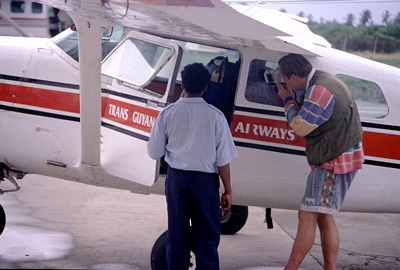
RIGHT: Part of Mazaruni River. |
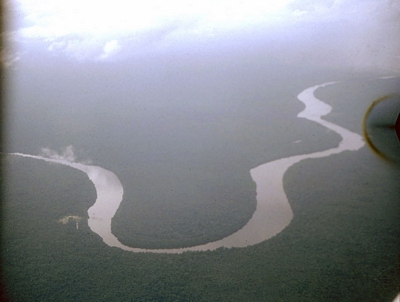
|
It was a nice flight, just with a few rain showers, the flight took approximately 1.5 hours.
The airstrip in Kamarang. |
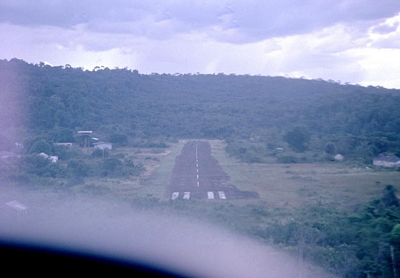
|
When we landed in Kamarang we were met by the police. The pilot just filled up the plane and dissapeared; they could not fly when it was dark, so he had to get back when it was light.
We were asked for our papers, so we showed them our passports. But that was not good enough. We should have a permit that allowed as to enter the village.
So instead of checking in at the Kamarang Guesthouse we had to carry our luggage down to the "Police station". Again they asked for the papers, which were given by the Home Office of Internal Affairs. They needed the paper, but we could not give them something we did not have. After writing down our passport numbers, they called for the Chief of the village, who was a woman. That did not help much, so at last they let us go, and said we should talk more the next day. So at last we could go to check-in at the Kamarang Guesthouse.
When we checked-in, the owner said he would talk with them the next day.
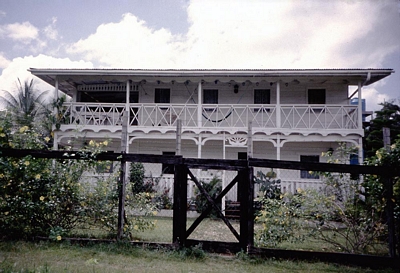
Kamarang Guesthouse. |
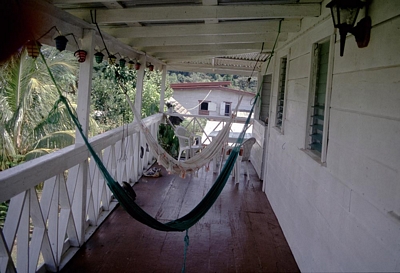
The Guesthouse was okay, and there were also hammocks on the porch to relax in. |
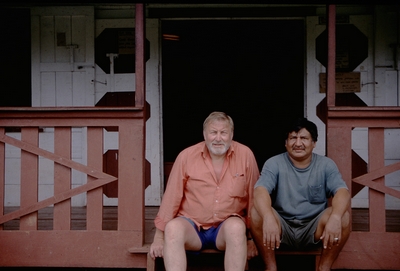
Here I'm sitting with the owner of the Kamarang Guesthouse and the shop, Ovid is his name. He was a great guy and he also played guitar. |
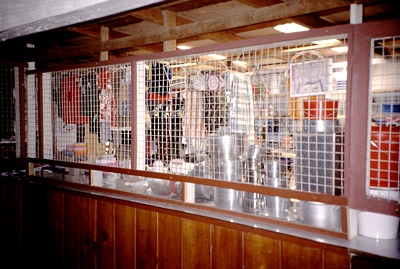
In his shop he had everything. |
The Chief came the day after and said she would allow us to go out on the river and collect fish. We had to use one of the village canoes, and we had to use local people and a policeman, so we could not do anything wrong.
We took our equipment, hammocks, camping stove and food. Then we carried the things down to the river where they would pick us up. They came and we put our things into the canoe, but when we started the canoe could not gather speed; the propeller was on the surface. So we drove to the other side of the river where they talked to each other in the Indian dialect, and we did not understand a word. We had come to the other side, and we were waiting, on what?
Then an Indian came with a chainsaw with a very long blade. They discussed with each other where to cut. We did understand that the outboard motor was too short, so it did not get deep enough. So they would cut some of the boards so the outboard could get deeper.
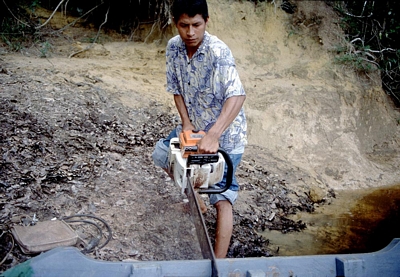
Here, he starts cutting. A small chainsaw? |
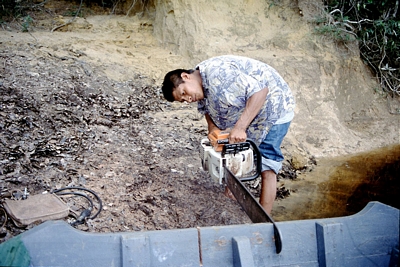
Here he's cutting again. |
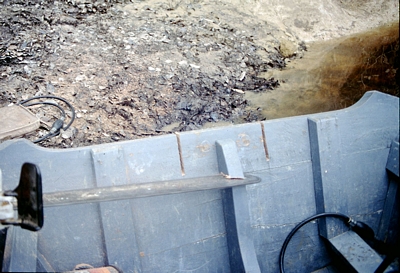
Then it was the beam. |
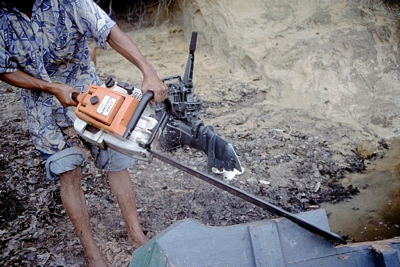
And the finishing touch. |
Then we started down the river, and everything went well. We wanted to go down to a place they called Pepper Camp.
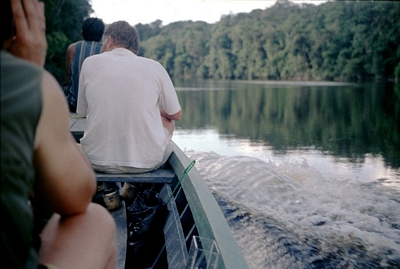
. |
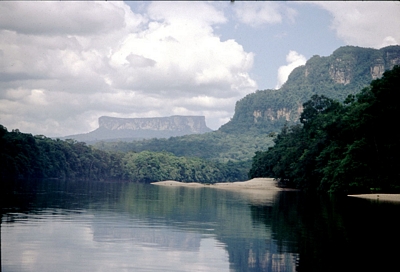
Nice mountain in the background. |
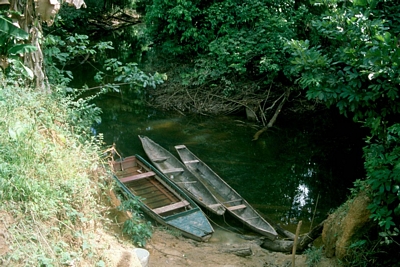
Biotope for Aequidens potaroensis. Today this fish has changed genus to Krobia potaroensis. There were also Mazarunia mazarunii here, and that was the fish I was most interesting in. There were also some different tetras in the biotope too, but I concentrated on the Mazarunia. |
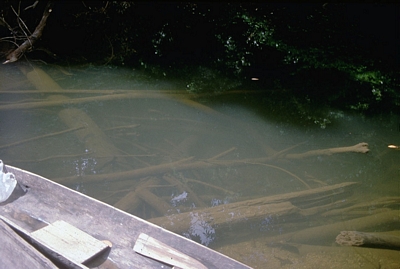
It was not an easy biotope to collect in, there were branches and logs, but I managed to collect some. |
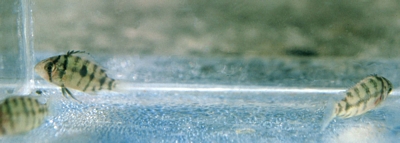
Young Mazarunia mazarunii.
A young Krobia potaroensis. |
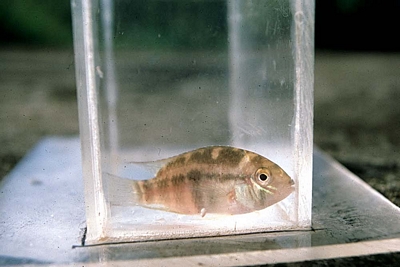 |
When we had collected fish, we crossed the river to Peppercamp where we could hang up our hammocks and make some food.
The dark came fast, but we managed to make some food. The next day we were going back to Kamarang, but after breakfast we intended to collect a little more before going up the river.
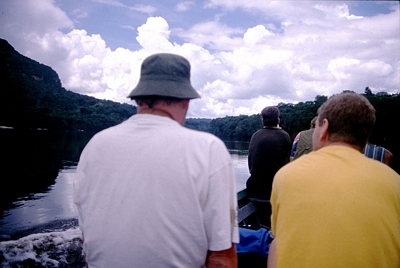
Here we are on our way up the river to Kamarang, and we checked into the Guesthouse again. |
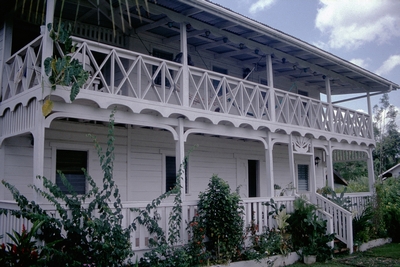
.
|
In the evening we were invited by Ovid into his "gambling house" and had a good time. Ovid gave us rum, but he did not have anything to mix it with, so we had to use water. It did not taste that good in the beginning, but after a few, it tasted better. Ovids "gambling house" had a billiard table and a ping-pong table. It must have cost a lot of money to get the billiard table up here by plane.
Ovid took his guitar and started singing; the rum was working, but he was good to play and sing.
The day after, we decided to see if we could get a plane back to Georgtown. There was no reason to hang around here when we could not collect fish. We went to the office that was handling this and asked if a plane was coming today. We were lucky he said, there was a big plane coming after lunch, but they could not promise there were places available.
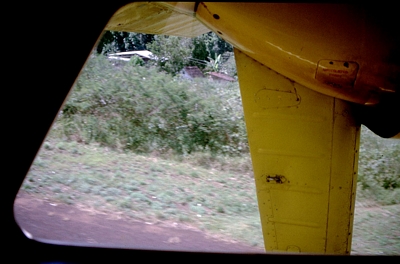
The plane came and we got places. They kicked out two and told them to wait, we were a group and should go together. |
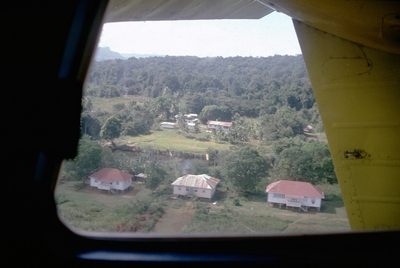
Here we see a part of Kamarang from the air. There could have been room for more people in the plane, but gas is more valuable than passangers. They had to transpor the gas by plane. The empty barrels needed space and were more important than the passengers. |
Inside the plane, there was no safety belt or anything, we sat among the empty barrels, but we got back to Georgetown.
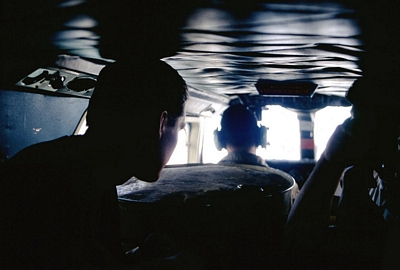
Barrels in front of Tor Atle. |
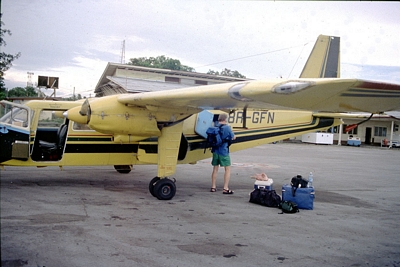
When we landed, the pilots went away, so we had to get the luggage out by ourselves. |
Then it was a taxi back to Rima Guesthouse. We wanted to visit the Kaiture Falls before we left Guyana, but I did not go with the others.
I had a fever because of an infection in my left arm. We went to the hospital to check my arm. It was so swollen it reminded me of Popeye's arms. They stuck a needle in my arm, and matter came out. So they gave me some tablets for the fever and put on a bandage. The fever came down and we started packing to go home.
When I came home there were more tablets, and it took three months to get rid of the infection. But it was nearly worth it for the trip.
So I stop the story here and start planning for a new trip. I hope you enjoy the article.